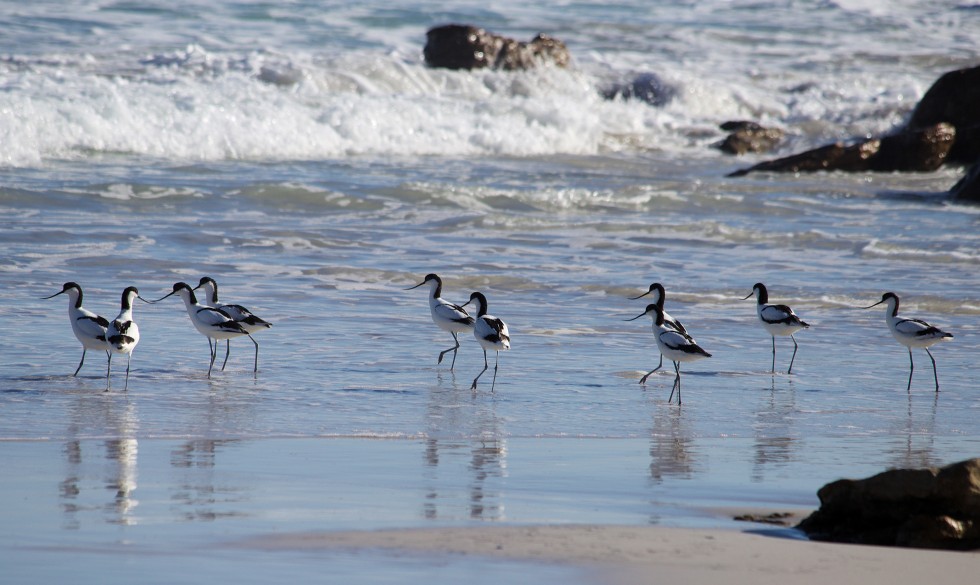Avocet & Stilt Week
Avocet Species Spotlight: Andean, Pied, Red-necked, and American
On this second day of Avocet & Stilt Week, we're introducing you to three new Birdorable species.
The avocets are a remarkable group of wading birds within the avocet and stilt (Recurvirostridae) family, known for their elegant appearance and unique feeding techniques. Among the four total species of avocets, the Andean Avocet, Pied Avocet, and Red-necked Avocet stand out for their distinctive traits and habitats. Let’s take a closer look at these fascinating birds that are new to Birdorable.

Andean Avocet
Andean Avocet (Recurvirostra andina)
The Andean Avocet is a striking bird native to the high-altitude wetlands of the Andes Mountains in South America. Unlike its relatives, which are often found in lowland coastal areas, the Andean Avocet is adapted to life in a more extreme environment, living at elevations ranging from 3,500 to 4,700 meters (about 11,500 to 15,400 feet) above sea level. This avocet, like the others in the family, is easily recognized by its black and white body plumage and its long, slender, upturned bill. The bill is particularly important for its feeding strategy, allowing the Andean Avocet to sweep through the shallow waters of high-altitude lakes and salt flats in search of small aquatic invertebrates. Its long legs enable it to wade through deeper waters, accessing food that other birds cannot reach. The Andean Avocet’s choice of such harsh habitats helps it avoid competition, but it also means it must be resilient to extreme temperatures and limited food resources.

Pied Avocet
Pied Avocet (Recurvirostra avosetta)
The Pied Avocet is perhaps the most iconic of the avocet species, known for its striking black-and-white plumage. Found across Europe, Asia, and Africa, the Pied Avocet inhabits coastal and inland wetlands, including estuaries, mudflats, and saline lagoons. Its elegant appearance is matched by its unique feeding technique, known as "scything." The Pied Avocet swings its upturned bill from side to side in the water, catching small crustaceans, insects, and other invertebrates. This feeding method is highly efficient, allowing the bird to cover large areas of shallow water quickly. The Pied Avocet is also known for its strong social behavior, often nesting in large colonies. This communal nesting strategy provides safety in numbers, as many eyes are on the lookout for predators. The Pied Avocations adaptability to various wetland environments and its striking appearance make it a favorite among birdwatchers across the pond.

Red-necked Avocet
Red-necked Avocet (Recurvirostra novaehollandiae)
The Red-necked Avocet is a species native to Australia, where it can be found in shallow inland wetlands, including salt lakes, swamps, and coastal estuaries. This avocet is easily identified by its reddish-brown head and neck, contrasting with its white body and black wings. Like its relatives, the Red-necked Avocet uses its upturned bill to feed by scything through the water, capturing small invertebrates and other aquatic prey. The Red-necked Avocet is well-adapted to Australia’s often harsh and variable climate, capable of traveling long distances to find suitable feeding and breeding grounds. During dry periods, these birds may move to coastal areas or more permanent water bodies. Their ability to adapt to changing environments is key to their survival in a land known for its extreme weather conditions.

American Avocet
American Avocet (Recurvirostra americana)
The American Avocet is a striking wader native to North America, easily recognized by its long, upturned bill, black-and-white wings, and elegant, slender build. During the breeding season, adults have a beautiful cinnamon-colored head and neck, which turns to grayish-white in the winter. This species is commonly found in shallow wetlands, including freshwater and saline lakes, marshes, and mudflats. This graceful bird is also known for its distinctive behavior of nesting on the ground, often on small islands or in sparsely vegetated areas near water. This iconic species joined Birdorable in 2010!

Pied Avocets at Table Mountain National Park in South Africa
Each of these avocet species—Andean, Pied, and Red-necked—has developed unique adaptations that allow them to thrive in their respective habitats. From the high-altitude wetlands of the Andes to the estuaries of Europe and Asia, and the salt lakes of Australia, avocets are a testament to nature's ability to shape species to fit their environments. Their specialized feeding techniques, striking appearances, and ability to adapt to diverse habitats make avocets some of the most fascinating birds to observe in the wild.
In total there are four avocet species in the world, and with the addition of these three joining the Birdorable American Avocet, we now have all of the birds in this group here in our flock!



Comments
Leave a comment
Thank you!